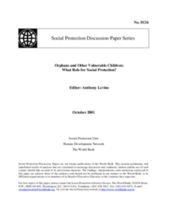A recent study estimated that 34.7 million children are orphans in 34 countries with high rates of HIV/AIDS. In Uganda, orphans constitute 20 percent of children younger than 15, in Malawi, 16 percent. Even if HIV infection rates level off now, the number of orphans in these countries will reach 44.2 million by 2010 and continue to climb until 2030.
The relentless growth in the size of the population of orphans and vulnerable children has precipitated a multifaceted care burden that too will grow for the next 20 years. Children whose parents die work more, attend school less, fall sick more often, and suffer higher tendencies toward social pathology. Caring for these orphans increases the vulnerability of the families and communities that take them in, reduces household income and food security, stretches social services, and undermines community cohesion. The damage to these orphans’ children, who will grow up without grandparents, is as yet undocumented.
This report records the proceedings of the conference Orphans and Other Vulnerable Children: What Role for Social Protection? which took place in Washington, DC in June 2001. Co-sponsored by the World Bank and World Vision, the two-day conference sought to promote awareness of the extent of this crisis, to provide practitioners with a forum to share best practices and other insights, and to probe the role of social protection in implementing a balanced response.
©The World Bank

